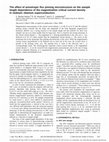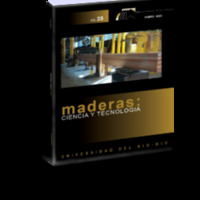Papers by Cristina Bormio-Nunes

Journal of Applied Physics, 1996
Artificial pinning center (APC) Nb 47 wt % Ti composite wires containing 24 vol % Nb pins were ch... more Artificial pinning center (APC) Nb 47 wt % Ti composite wires containing 24 vol % Nb pins were characterized as the wire diameter was reduced. As the nominal pin diameter dp was reduced from 165 to 15 nm, the nominally round pins transformed into ribbons with a relatively wide distribution in thickness, as compared to the α-Ti ribbons in optimized, conventionally processed Nb 47 wt % Ti. The maximum in the bulk flux pinning force Fp of 25 GN/m3 (4.2 K, 2.5 T) occurred at dp=40 nm, for which the measured Nb ribbon thickness ranged from 1 to 16 nm. This Fp value was about one third higher than that found in the best conventional Nb 47 wt % Ti. The upper critical magnetic field Hc2, measured by magnetization, decreased from 10.3 to 9 T as the Nb pins became proximity-effect coupled to the matrix. To better compare APC and conventional wires, we measured the properties of the best APC wire at a reduced temperature so that its Hc2 was the same as Hc2(4.2 K) for Nb 47 wt % Ti. The peak va...

Journal of Applied Physics, 1996
Magnetization measurements of the critical current density Jc in Nb 47 wt % Ti with Nb artificial... more Magnetization measurements of the critical current density Jc in Nb 47 wt % Ti with Nb artificial pinning centers revealed that the shape and magnitude of the field dependent magnetization hysteresis ΔM(H) was a strong function of the sample length and that ΔM(H) for short wire samples was up to six times smaller than for long wires. This is caused by the strong anisotropy of the critical current density Jc. The magnitude of Jc flowing perpendicular to the wire axis J⊥ was deduced to be 50–175 times smaller than the longitudinal current density J∥. The source of the anisotropy lies in the anisotropic flux pinning microstructure of the wires. When the magnetization current crosses perpendicular to the filament axis at each end of the wire, the Lorentz force is parallel to the pinning center axis. The pinning force is weak in this direction and J⊥ is correspondingly small. The technologically important critical current density is the longitudinal current density J∥. It can be extracte...
IEEE Transactions on Appiled Superconductivity, 1997
IEEE Transactions on Appiled Superconductivity, 1997
IEEE Transactions on Applied Superconductivity, 2011
is one of the most used superconducting ma- terials for applications in high magnetic fields. The... more is one of the most used superconducting ma- terials for applications in high magnetic fields. The improvement of the critical current densities is important, and must be analyzed together with the optimization of the flux pinning acting in the material. For , it is known that the grain boundaries are the most effective pinning centers. However, the introduction of artificial
Superconductor Science and Technology, 2003
Quantitative data on the diffusion between Nb and Ti are important for the processing of Nb-Ti su... more Quantitative data on the diffusion between Nb and Ti are important for the processing of Nb-Ti superconductor wires through the 'artificial pinning centre-diffusion process'. In the literature, most of the Nb-Ti diffusion studies are focused on the 1173-1973 K temperature range which is inappropriate for this application. The objective of this study was to evaluate the diffusion between Nb and











Uploads
Papers by Cristina Bormio-Nunes